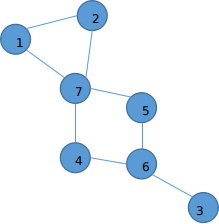T1: Given a string a and a string b, B is the prefix of A. If a character x is added after a string b, the longest prefix length of a string is the same as that of B string.
(lb <= la <= 2*lb lb <= 100,000)
kmp nude questions...
However, I didn't see the data range clearly during the exam. I only opened twice the lb. See you at 91:00.
So throw a wave of boards.
1 for(int i=2;i<=n;i++) { 2 int p=i-1; 3 while(p&&s[i]!=s[nxt[p]+1]) p=nxt[p]; 4 if(s[i]==s[nxt[p]+1]) nxt[i]=nxt[p]+1; 5 else nxt[i]=0; 6 }
T2: Given an undirected graph with n points and m edges, find the necessary points from 1 to n.
(n <= 200,000 m <== 2*n) (there may be self-rings and double edges)
At first glance, it is obvious that naked tarjan, happy heart 5 minutes to complete the tarjan cut point board, output all cut points, and then run through the sample to see T3:)
T3 can't imagine, idle boredom began to build T2 data, and as a result, a random group of them killed themselves...
As shown in the figure:

An awkward discovery is not necessarily a cut-off point!
So Ctrl+A, Delete:(
(Refactoring is good o_o#)
To reconstruct, we still need tarjan, which involves cut points, but is not a simple calculation and judgment, that is, point double shrinkage points or square trees.
Nevertheless, after learning the garden square tree, I have never written double-indentation points which are complex, detailed, space-occupying and difficult to write.
So I began to think about how to use the square tree to calculate the answer.
Because the square tree will turn the original picture into a tree, it is easy to find that the answer is the dots on the chain from 1 to n on the square tree.
So it's done.
What? You said you couldn't make a square tree?
Laikang Little Pink Rabbit's Blog
What? You don't tarjan yet? Please skip this question...
t2 Code 1 #include<cstdio> 2 #include<iostream> 3 #include<cmath> 4 #include<algorithm> 5 #include<cstring> 6 #include<vector> 7 #include<queue> 8 #define ll long long 9 using namespace std; 10 const int MAXN=200005; 11 int T,n,m,dfn[MAXN],low[MAXN],stk[MAXN],fa[MAXN*2],num,tp,dcc_cnt; 12 bool flag; 13 inline int R() { 14 int a=0;char c=getchar(); 15 while(c>'9'||c<'0')c=getchar(); 16 while(c>='0'&&c<='9')a=a*10+c-'0',c=getchar(); 17 return a; 18 } 19 struct node { 20 int to,nxt; 21 }mp[MAXN*8]; 22 int h[MAXN*2],tot; 23 void add(int x,int y) { 24 mp[++tot].to=y;mp[tot].nxt=h[x];h[x]=tot; 25 } 26 void tarjan(int u) { 27 dfn[u]=low[u]=++num; 28 stk[++tp]=u; 29 for(int i=h[u];i;i=mp[i].nxt) { 30 int v=mp[i].to; 31 if(!dfn[v]) { 32 tarjan(v); 33 low[u]=min(low[u],low[v]); 34 if(low[v]==dfn[u]) { 35 ++dcc_cnt; 36 int tmp; 37 do { 38 tmp=stk[tp--]; 39 add(dcc_cnt+n,tmp); add(tmp,dcc_cnt+n); 40 }while(tmp!=v); 41 add(dcc_cnt+n,u); add(u,dcc_cnt+n); 42 } 43 } 44 else low[u]=min(low[u],dfn[v]); 45 } 46 } 47 void dfs(int u) { 48 if(u==n) { 49 flag=1; 50 return; 51 } 52 for(int i=h[u];i;i=mp[i].nxt) { 53 int v=mp[i].to; 54 if(v==fa[u]||(u<=n&&v<=n)) continue; 55 fa[v]=u; 56 dfs(v); 57 if(flag) return; 58 } 59 } 60 int main() { 61 T=R(); 62 while(T--) { 63 n=R();m=R(); 64 for(int i=1,aa,bb;i<=m;i++) { 65 aa=R(),bb=R(); 66 add(aa,bb); add(bb,aa); 67 } 68 tarjan(1); 69 dfs(1); 70 int p=fa[n]; 71 tp=0; 72 while(p!=1) { 73 if(p<n) stk[++tp]=p; 74 p=fa[p]; 75 } 76 sort(stk+1,stk+tp+1); 77 printf("%d\n",tp); 78 for(int i=1;i<=tp;i++) printf("%d ",stk[i]); 79 printf("\n"); 80 memset(dfn,0,sizeof(dfn)); 81 memset(low,0,sizeof(low)); 82 memset(h,0,sizeof(h)); 83 memset(fa,0,sizeof(fa)); 84 num=0;tot=0;tp=0;flag=0;dcc_cnt=0; 85 } 86 return 0; 87 }
1 #include<cstdio> 2 #include<iostream> 3 #include<cmath> 4 #include<algorithm> 5 #include<cstring> 6 #include<vector> 7 #include<queue> 8 #define ll long long 9 using namespace std; 10 const int MAXN=200005; 11 int T,n,m,dfn[MAXN],low[MAXN],stk[MAXN],fa[MAXN*2],num,tp,dcc_cnt; 12 bool flag; 13 inline int R() { 14 int a=0;char c=getchar(); 15 while(c>'9'||c<'0')c=getchar(); 16 while(c>='0'&&c<='9')a=a*10+c-'0',c=getchar(); 17 return a; 18 } 19 struct node { 20 int to,nxt; 21 }mp[MAXN*8]; 22 int h[MAXN*2],tot; 23 void add(int x,int y) { 24 mp[++tot].to=y;mp[tot].nxt=h[x];h[x]=tot; 25 } 26 void tarjan(int u) { 27 dfn[u]=low[u]=++num; 28 stk[++tp]=u; 29 for(int i=h[u];i;i=mp[i].nxt) { 30 int v=mp[i].to; 31 if(!dfn[v]) { 32 tarjan(v); 33 low[u]=min(low[u],low[v]); 34 if(low[v]==dfn[u]) { 35 ++dcc_cnt; 36 int tmp; 37 do { 38 tmp=stk[tp--]; 39 add(dcc_cnt+n,tmp); add(tmp,dcc_cnt+n); 40 }while(tmp!=v); 41 add(dcc_cnt+n,u); add(u,dcc_cnt+n); 42 } 43 } 44 else low[u]=min(low[u],dfn[v]); 45 } 46 } 47 void dfs(int u) { 48 if(u==n) { 49 flag=1; 50 return; 51 } 52 for(int i=h[u];i;i=mp[i].nxt) { 53 int v=mp[i].to; 54 if(v==fa[u]||(u<=n&&v<=n)) continue; 55 fa[v]=u; 56 dfs(v); 57 if(flag) return; 58 } 59 } 60 int main() { 61 T=R(); 62 while(T--) { 63 n=R();m=R(); 64 for(int i=1,aa,bb;i<=m;i++) { 65 aa=R(),bb=R(); 66 add(aa,bb); add(bb,aa); 67 } 68 tarjan(1); 69 dfs(1); 70 int p=fa[n]; 71 tp=0; 72 while(p!=1) { 73 if(p<n) stk[++tp]=p; 74 p=fa[p]; 75 } 76 sort(stk+1,stk+tp+1); 77 printf("%d\n",tp); 78 for(int i=1;i<=tp;i++) printf("%d ",stk[i]); 79 printf("\n"); 80 memset(dfn,0,sizeof(dfn)); 81 memset(low,0,sizeof(low)); 82 memset(h,0,sizeof(h)); 83 memset(fa,0,sizeof(fa)); 84 num=0;tot=0;tp=0;flag=0;dcc_cnt=0; 85 } 86 return 0; 87 }
T3: Gossip first
